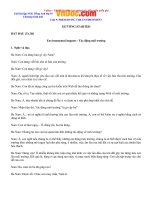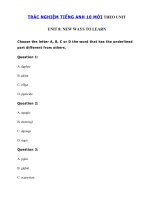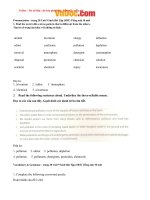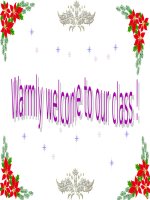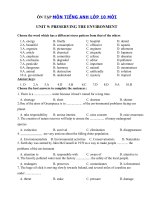Unit 9. Preserving the Environment. Lesson 3. Reading
Bạn đang xem bản rút gọn của tài liệu. Xem và tải ngay bản đầy đủ của tài liệu tại đây (88.55 KB, 3 trang )
<span class='text_page_counter'>(1)</span><div class='page_container' data-page=1>
Preparing date: March 13th<sub>, 2018 Teaching date: March 16 </sub>th<sub>, 2018 </sub>
Class: 10C8 Period:
Student Teacher: Vu Thi My Hanh
Teacher: Phạm Thi Lan Oanh
<b> </b>
<b> UNIT 9: PRESERVING THE ENVIRONMENT </b>
<b>Lesson 3: Reading</b>
<b>I/ Objectives: </b>
By the end of the lesson, students will be able to:
<b>1. Knowledge: ( 3 basic levels: recognition, comprehension, </b>
application).
- Vocabulary: read, write, and understand key words or phrases related
to preserving the environment.
- Language: use structure, vocabulary to do Activity required.
<b>2. Skills: </b>
<b>-</b> Read for general ideas and for specific information about threats to
natural environment and do activities.
- Skimming and scanning reading
<b>3. Attitude and competencies:</b>
- Have a positive attitude towards what they have learnt.
- Understand and actively respond to relevant matters or situations.
<b>II/ Preparations:</b>
- Teacher: Handouts, textbook, pieces of papers and laptop.
<b>-</b> Students: Textbook.
<b>III/ Anticipated problems and solutions:</b>
- Students may not be used to the way of reading and doing the
activities.
- So prepare and explain carefully before asking them to do.
<b>IV/ Procedures:</b>
<b>TEACHERS AND STUDENTS’</b>
<b>ACTIVITIES</b>
<b>CONTENTS AND BOARD</b>
<b>DISPLAY</b>
<b>1. Warm-up( 5 minutes work in groups)</b>
-T gives Ss a game, the name of the game is: “
Puzzle” and then Ss talk about their type of
pollution from picture
<b>Suggested answers:</b>
a. greenhouse effect
b. pollution
c. deforestation
<b>Suggested answers:</b>
a. greenhouse effect
b. pollution
</div>
<span class='text_page_counter'>(2)</span><div class='page_container' data-page=2>
d. polar ice melting
e. fossil fuels
d. polar ice melting
e. fossil fuels
<b>2. New lesson</b>
<b>Activity 1: (7 minutes- individual)</b>
- Let Ss look at the photos and the instructions.
T asks:
+ What can you see in the photos?
+ What is the environmental impact in each
photos?
- Ss elicit the answers and put them on the board.
- T gives feedback.
<b>Activity 2: (7 minutes- individual)</b>
- T asks Ss to read the instruction and the options
carefully, and underline any key words that may
help them predict the content of the text.
- T allows enough time for Ss to skim the
paragraphs quickly. Encourage Ss to share their
ideas with their partners.
- T checks the answer.
<b>Activity 3: (7 minutes- work in groups )</b>
- T focuses Ss attention on the instruction. Write
all the highlighted words from the reading text on
the board.
- T goes over the definitions with the whole class.
- T checks comprehension and has Ss match the
words.
- Alternatively, T asks Ss to work in groups.
<b>Activity 4 ( 7 minutes- group work)</b>
- T asks Ss to read the instructions carefully, and
underline the key words in the sentences provided.
- T encourages Ss to underline the parts of the
reading text relevant to the statements.
- T devides class into 4 groups.
- T checks answer as a class, and encourages Ss to
justify their choices by referring to the relevant
information in the reading text.
<b>UNIT 9 : PRESERVING THE</b>
<b>ENVIRONMENT</b>
<b>Lesson 3:Reading</b>
<b>Activity 1: </b>
<b>Key:</b>
a. noise pollution
b. water pollution
c. air pollution
d. soil pollution
<b>Activity 2:</b>
<b>* Answer: </b>
C
<b>Activity 3:</b>
<b>Key</b>
1. ecosystem
2. pesticides
3. inorganic
4. vegetation
5. fertilizer
6. pollutants
<b>Activity 4:</b>
<b>* Key:</b>
1. F
2. F
3. T
4. T
5. T
6. T
1. Environmental pollution is one of
the impacts of human activities.
</div>
<span class='text_page_counter'>(3)</span><div class='page_container' data-page=3>
<b>Activity 5 ( 7 minutes- groups work)</b>
- T asks Ss some guiding questions before their
discussion:
1. <i>What type of pollution is there in your </i>
<i>neighbourhood? </i>
<i>2.What are the causes and effects? </i>
<i>3.How can you help reduce this type of pollution?</i>
- T arranges Ss into group of 4 and let them
discuss the question.
<b>Suggested answers:</b>
There is soil pollution in my neighbourhood.
People throw much garbage on the ground. This
makes the soil contaminated. This also
creates/causes the decrease of soil fertility.
<b>Activity 5:</b>
Guiding questions before their
discussion:
<i>1.What type of pollution is there in </i>
<i>your neighbourhood? </i>
<i>2. What are the causes and effects? </i>
<i>3. How can you help reduce this type of</i>
<i>pollution?</i>
<b>Suggested answers:</b>
There is soil pollution in my
neighbourhood. People throw much
garbage on the ground. This makes the
soil contaminated. This also
creates/causes the decrease of soil
fertility.
<b>3.Consolidation: (2 minutes- whole class) </b>
- T asks Ss: What have you learnt today? What
can you do now?
- Summarize the main points of the lesson
<b>4. Homework: (1 minute- whole class)</b>
- T asks students to make the sentence with the
new words.
- Prepare for the next lesson.
<b>Feedback: </b>
...
...
...
...
...
<i>Tiên Lãng, ngày tháng năm 2018</i>
<b>Phê duyệt của giáo viên hướng dẫn Người lập kế hoạch</b>
</div>
<!--links-->




